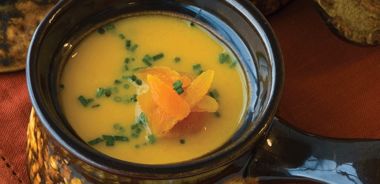Family-Friendly Sweet Potato Soup

An all-around winner for the entire family, this sweet potato soup is slightly sweet with just a hint of spice. The addition of dried apricots makes this soup a beta carotene star, which helps stimulate your body’s immune system—a definite plus in the winter months.
1 Tbsp (15 mL) extra-virgin olive oil
4 shallots, coarsely chopped
4 cups (1 kg) sweet potatoes, peeled and coarsely chopped
1/4 tsp (1 mL) freshly cracked pepper
4 cups (1 L) low-sodium chicken stock
8 whole, organic, sulphite-free dried apricots
Heat medium pot over medium heat. Add oil and shallots. Saute till shallots are slightly golden brown, about 4 minutes. Add sweet potatoes and pepper. Saute for 2 minutes.
Pour in chicken stock. Add apricots. Bring to the boil, cover, reduce heat to low, and simmer for 30 minutes or until sweet potatoes are soft.
Remove soup from heat. Purée soup using a hand-held immersion blender or transfer soup to a blender. Purée till smooth. Serve.
Makes 7 cups (1.75 L).
Each 1 cup (250 mL) serving contains: 98 calories; 2.4 g protein; 1.9 g total fat (0 g sat. fat, 0 g trans fat); 16 g carbohydrates; 2 g fibre; 351 mg sodium
source: "Winter Vegetables", alive #327, January 2010




